Joni Mitchell: Following Her Iconic Grammys Performance, Tracing a Life Inspired by Mitchell’s Music

Joni Mitchell, 80, poses with her Best Folk Album Grammy, which she won on Sunday ahead of her live performance on the Grammy broadcast – the first time Mitchell ever performed at the ceremony. Photo: Emma McIntyre/Getty Images for The Recording Academy
Joni Mitchell performed for the first time ever at the Grammys on Sunday night, capping a triumphant return to music in recent years following a near-fatal 2015 brain aneurysm. The legendary 80-year-old Canadian troubadour’s live rendition of her classic “Both Sides Now,” which she sang while seated in an armchair and gripping – and, at times, tapping – her walking stick, led to a standing ovation from a teary-eyed crowd (see video below).
Singer Brandi Carlile, who’s been instrumental in Mitchell’s return to the stage and who also performed alongside her at the Grammys, introduced the Alberta-born legend by noting. “Joni is one of the most influential and emotionally generous creators in human history. She redefined the very purpose of a song to reflect the contents of a person’s soul … Before she took this leap, the popular song was observational. It was brilliant and influential, of course, but the exhilarating risk that we all now take by turning ourselves inside out for all the world to see started, as far as I can tell, with Joni Mitchell doing it first.”
Carlile also noted the personal adversity Mitchell has had to overcome through the years, including learning to walk three times.
Mitchell herself also won a Grammy on Sunday for Best Folk Album for Joni Mitchell at Newport, the live album documenting her return to live performing (at the urging of Carlile) in 2022 at the Newport Folk Festival. Mitchell performed her first headlining show in more than 20 years in 2023 at the Gorge Amphitheatre in Washington State.
In honour of Mitchell’s Grammy performance, we revisit our 2023 story in which one longtime Joni Mitchell fan recounts his numerous meetings with the beloved troubadour and how her music has impacted his life. —Mike Crisolago
Song for Joni: Tracing a Life Inspired by the Music of Joni Mitchell

March 31, 2015. To most people, this date holds no special significance. But for me, it was a day filled with fear, dread, anxiety and sadness.
The media had been busy breaking the alarming news that the then 71-year-old Joni Mitchell had been discovered alone and unconscious (for three days, it was later revealed) in her secluded Spanish colonial home tucked high into the hills of Bel Air, one of Los Angeles’ most private neighbourhoods. For any devoted lifelong fan like myself, the news was devastating.
To contemplate the now very real possibility that the woman who I had for many years referred to as my “spiritual mother” could be snuffed out so suddenly, without warning, was terrifying.
That is why, as I watched her grace the stage of the Gorge Amphitheatre at dusk this past June 10, perched atop the basalt cliffs that line the Colombia River in rural Washington state, it felt like an impossible dream come to life — a miracle that neither I, nor any of the close to 28,000 others in attendance, could, or would, have ever imagined possible.
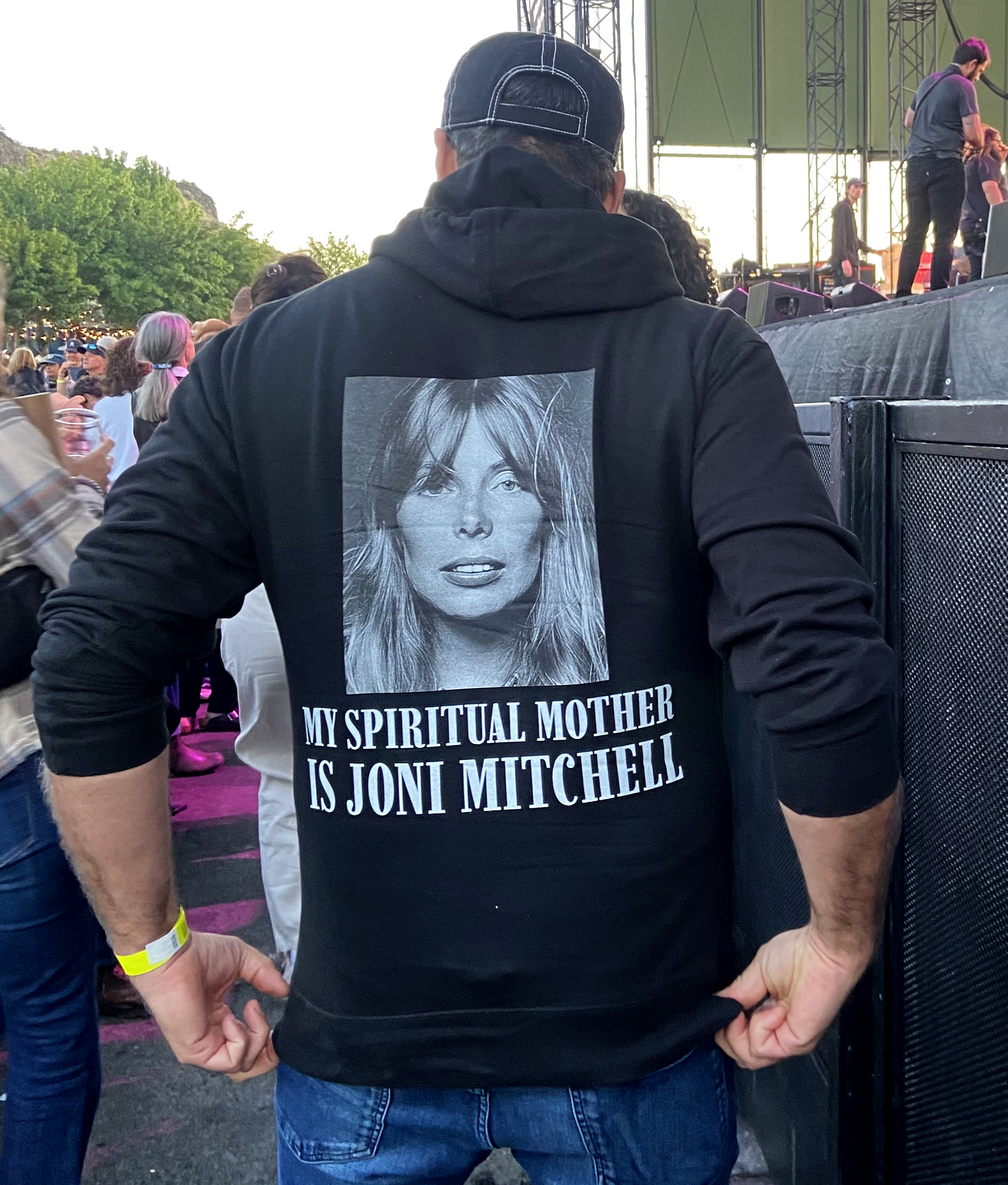
But there she was. This now 79-year-old icon; the artistic curious girl from the Canadian prairies who had overcome polio as a child through sheer willpower; the rebellious rock ’n’ roll-loving teenager who had refused to let a conservative upbringing extinguish her desire to follow a creative and unconventional life path; the “destitute unwed mother” who had endured the immense trauma of secretly surrendering her infant daughter for adoption, feeling abandoned, hopeless and utterly alone; the once young bride who had escaped a doomed marriage from a controlling, disingenuous and manipulative husband; and now, the phoenix rising from the ravages of a brain aneurysm that had left her unable to talk or walk on that March day eight long years ago.
If nothing else, Joni Mitchell’s life has been a masterclass in resilience, grit and self-determination. And now it felt like, perhaps, this fearless trailblazer who had wielded her emotions and vulnerability like a kind of superpower her entire life was finally being publicly acknowledged by many as the greatest singer-songwriter of the modern era.
Songs to Aging Children Come
My own connection to Joni has been lifelong and deeply layered. Due to both my mother and older brother’s penchant for her music, Mitchell’s work has been a constant since before I could walk or talk. In elementary school, her two 1974 releases, the studio album Court & Spark and live double album Miles of Aisles, were in constant rotation on the 8-track player of my mother’s Plymouth Volaré station wagon. Meanwhile, regular chess and backgammon lessons in my brother’s bedroom would introduce and familiarize me to The Hissing of Summer Lawns from 1975 and Hejira, Joni’s 1976 release that many of her hardcore fans consistently cite as her magnum opus.
By the age of 10, I had become intimately familiar with a huge portion of Joni’s repertoire, absorbing and ruminating on both her uniquely emotive melodies and her provocative storytelling lyrics. Joni transported me to parks in Paris, cafés in Greece and parties in Spain. We took ferries to Staten Island, road trips through North Dakota junctions, stayed in blue hotel rooms in Savannah and flew above burning deserts “in jet planes at icy altitudes” en route to the place she had come to call home, Los Angeles, the “city of fallen angels,” in her mythical and beloved California.
From Beale Street to Bleecker Street, Joni captured my imagination and showed me an exciting, foreign, exotic and mystical world that seemed so far away from my snowed-in suburban childhood in Ottawa’s west end. And her guidance wasn’t just confined to geographical journeys — it was also her case studies on matters of the heart, examining and analyzing her life’s many euphoric but chronically doomed encounters with love and heartache, most often turning a critical gaze towards her own shortcomings as much as those of her friends and lovers. She imbued in me the importance of living a self-examined life well before it felt like mine had even begun. But most importantly, Joni Mitchell schooled me in the power of empathy.
Her many musical portraits depicted a vast cast of characters that were unique, imperfect, complex, tragic and, above all, human. Some were real, others imagined, but the majority were a seamless hybrid of both. She created musical fables that provided me with a nuanced roadmap of compassionate insight to my future self, illuminating the “noble causes and lonely landscapes” of this world in all of its messy, complicated glory.
A Strange Boy
Being a teenager in the ’80s, my love of Joni Mitchell was most often mocked, misunderstood or ignored by my peers, as her star had shined its brightest almost a decade earlier. At that point in time, she had been reduced to a counterculture cliché for my generation, a foggy symbol of the flower child era, forever framed as a peace and love magical hippie-chick princess.
“Isn’t she that folk singer from the ’60s?” a confused or suspicious girl in a Duran Duran T-shirt and sporting a Princess Di haircut might inquire with a derogatory sneer.
It was an exhausting and mostly futile exercise to explain to most of my friends why Joni was so much more than that, so I kept my relationship with her private for the most part.
However, when my Grade 11 history class required our term paper to feature a historically significant Canadian as its subject, I flexed a bit and enthusiastically submitted an essay entitled The Songs of Joni Mitchell: Comments on the Times. I can proudly report it received a grade of 92/100 with a handwritten “Excellent” scrawled across its cover page. It felt almost subversive to write about something I was so passionate about for a school assignment.
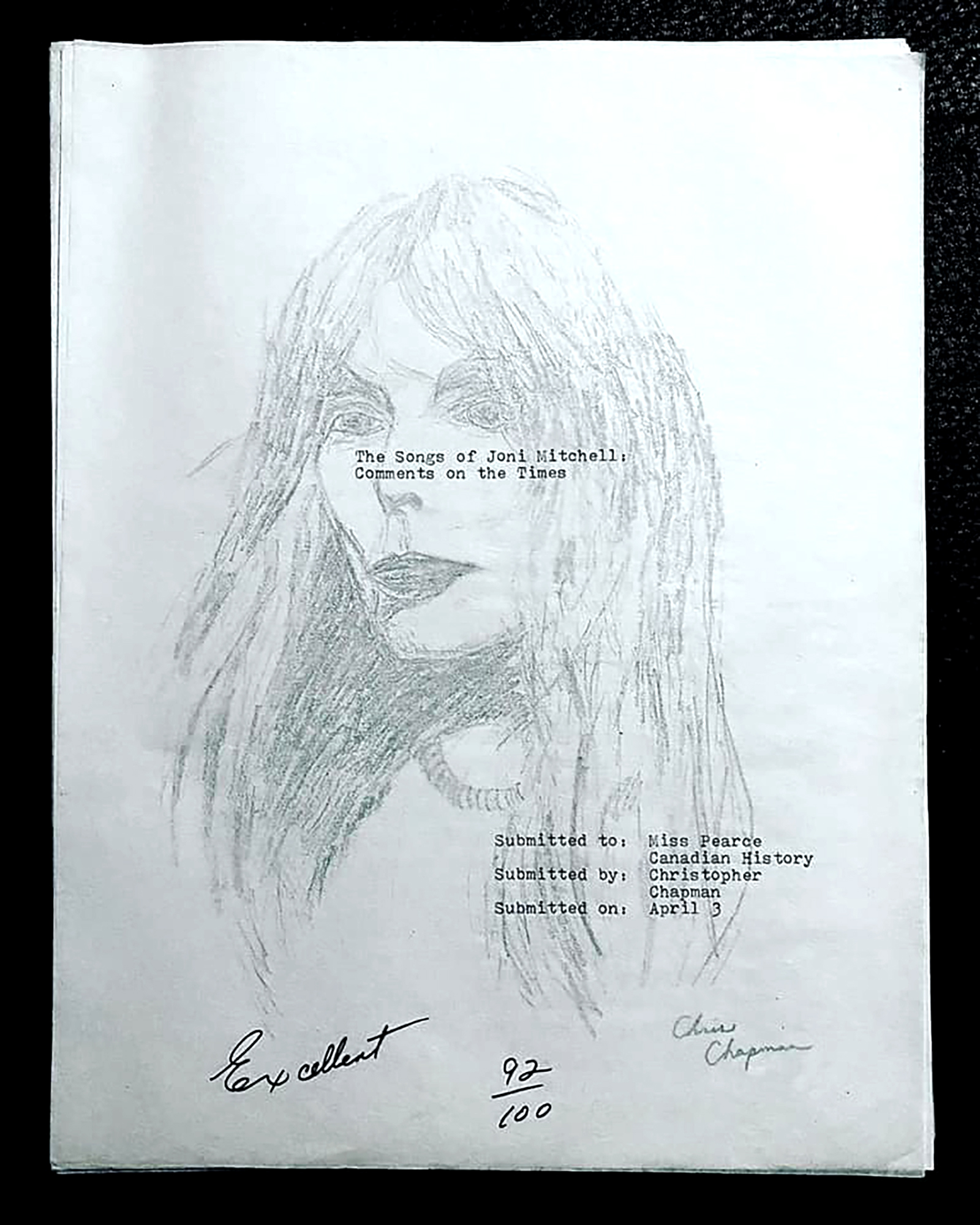
I eventually left Ottawa at 17 and, like my guru, followed my dream of pursuing an education in the arts. For Joni, that meant a move to Calgary and studies at the Alberta College of Art; for me, the destination was Toronto, where I enrolled in the Ontario College of Art, rebranded currently as OCADU.
After my first two years, I felt adrift, lost in a sea of possibilities with no clear idea of who I was or what I wanted to do with my life. I took a year off and spent it living abroad in London, where I came out as gay at 19. After acquiring some desperately needed real-world adventures, failed romances and culture clashes, I made my way back to Toronto the following year to complete my college curriculum with a clear plan towards focusing my studies on becoming a professional photographer.
No Regrets, Coyote
In 1994, four years after graduating from my program, I arrived home one late afternoon to find a message on my answering machine from a friend asking if I was aware that Joni Mitchell was in town and would be performing live that evening at MuchMusic to showcase her newest album, Turbulent Indigo. Shocked and incredulous, I jumped on my bike and hightailed it down to the CityTV building on Toronto’s Queen Street West. I quickly joined a small congregation of obvious Joniphiles gathering outside the tall street-level windows that opened up onto a large open-concept performance space inside, where an empty oversized couch sat facing a studio audience.
The exclusive and obviously well-connected attendees streamed past the velvet ropes while we watched from the sidewalk, all of us desperately wishing we could follow in their footsteps. Before long, Joni emerged with MuchMusic personality Denise Donlon, who was there to act as a master of ceremonies and delivery system for questions.
Joni regaled us all with stories and anecdotes surrounding the songs she performed, some of which were completely new and still unrecorded. About halfway through the night, during a commercial break, Joni requested they rejig her setup so she could perform the next segment for us, the small excluded group of ragtag fans delegated to a street level backside view of the proceedings thus far.
As the crew scrambled to relight and block the area directly in front of us, Joni approached with her guitar as I watched wide-eyed, in disbelief. Soon, she was serenading us with “Just Like This Train” and “Night Ride Home” while addressing questions posed about her fascinating life’s journey, from Saskatoon to Carnegie Hall. Responding with her characteristic warm authenticity, she made a point of always peppering serious replies with humour and wit. I was in heaven.
It was during this spectacle that I heard rumours of a planned appearance by Joni the following week on CTV’s The Dini Petty Show. Remembering I had an acquaintance who was employed as a producer there, I reached out to him to see if I could be a part of the studio audience. My wish was soon granted, and a few days later I would be on my way to the CFTO Agincourt studios in a rental car.
Before the taping began, my friend emerged to see if I wanted be one of the audience members to ask Joni a question. “Of course I do!” I squeaked, and frantically racked my brain to think of something I thought Joni would find interesting and original.
The show proceeded with a performance of her new song “The Magdalene Laundries” as well as the lesser-known, jazz-infused “Moon at the Window,” with Petty interrogating Joni about her manicure in between.
Soon, I was instructed to stand and rise as Petty raised her extended microphone to my face. After launching into a speedy monologue about how important an influence she had been on my life, squeezing in that I’d also brought a gift for her, I posited a question about three songs she’d recorded that had included an orchestral interlude in them — most notably, “Paprika Plains”, a 22-minute love letter to her childhood on the prairies from 1977’s under-appreciated double album Don Juan’s Reckless Daughter. I was curious if she had ever considered returning to a full symphonic sound like that in the future.
To my delight, Joni took a full five minutes to address this, and brought up anecdotes about improperly tuned pianos and her encounters with American jazz musician Charles Mingus in her reply. To my dismay, however, my question and her answer were promptly cut out of the eventual broadcast, most likely due to time constraints. As the show ended, and Joni was ushered off set, I realized the gift I’d brought was still in my hand. My brain then made the reckless decision to run down the stairs and hop the stage barrier so I could hand deliver my gift to Joni in a “now or never” rush of courage.
Seeing her just ahead of me pacing down a cavernous concrete corridor, I raised my arm, hand clenched around my offering and called out “Joni …. your necklace!” She stopped, did an about-face, saw me and exclaimed with a smile “Oh yeah!”
As I presented her with a sleek, ornate silver pendant I had brought back from a trip to China and strung to a thin leather cord, she examined it with genuine intrigue, pointing out the cross within a circle that was an integral part of the design.
“This is a Hopi symbol …” she explained, recounting to me what it represented within that culture, emphasizing how much it had always resonated with her personally. “You have no idea how much this means to me” she whispered, embracing me in her arms before squarely placing a kiss directly on my lips. I almost fainted.
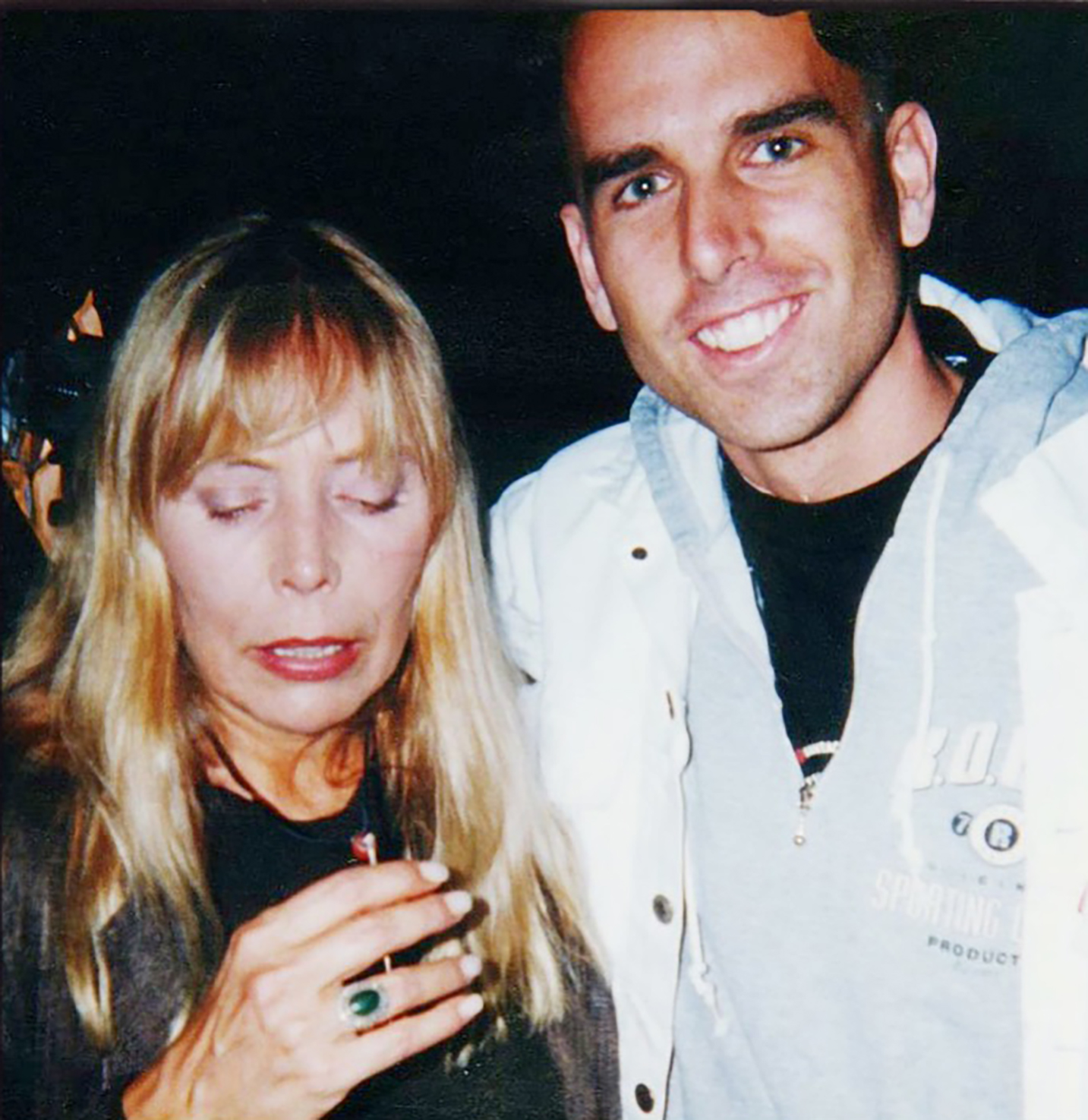
People’s Parties
Those events marked the first of many I would eventually attend in Joni’s honour over the next three decades. While working in New York in 1999, the stars aligned for me on Canada Day when “Joni’s Jazz,” a free concert in Central Park, was staged. It featured a diverse range of musicians that included Jane Siberry, Joe Jackson and Eric Andersen, all assembled to pay homage to a period of her work that had marked a significant stylistic shift.
The following year, I flew to Saskatoon to attend the opening of Voices: The Work of Joni Mitchell, her first complete retrospective as a visual artist, at the now defunct Mendel gallery. More than 85 of her paintings were showcased as well as a selection of music, writing, poetry and mixed-media artwork that had spanned her entire career. In 2001, she was back in Toronto to be honoured at the World Leaders: Festival of Creative Genius series, and again in 2007 for a gala celebrating her induction into the Canadian Songwriter’s Hall of Fame. James Taylor and Chaka Khan performed, while kindred spirit Margaret Atwood eloquently praised her onstage after breaking the ice with humour in her signature deadpan-style, intoning, “Joni Mitchell and I have some things in common … though I am older … and she is blonder.’
During this time, a significant shift in my own professional life had taken place. I was a part-time photographer/full-time waiter when I had first met Joni in 1994, still determined to make a name for myself in the highly competitive world of editorial and fashion photography.
But by the turn of the millennium, my career was in full swing. After I had become a founding contributor (and editor-at-large ) to the influential British interiors and lifestyle magazine Wallpaper in 1996, my work became much more visible, both nationally and internationally. For many years, I was a “global nomad,” shooting around the world for a variety of clients that included Holt Renfrew, Harry Rosen, Abercrombie & Fitch and The Gap.
When I met Suzanne Boyd, then editor of Canada’s most popular fashion magazine, Flare (and now the editor-in-chief and publisher of Zoomer) in 2001, she asked me if I would be interested in joining the ranks of an exclusive roster of photographers she regularly hired to create monthly fashion content for the magazine.
Confessing that I would be very excited about exploring some untapped and uniquely Canadian cultural moments as stylistic inspiration for the pages of Flare , I pitched her my three ”dream” fashion editorial ideas: one based on the infamous “bed-ins” of John Lennon and Yoko Ono in Toronto and Montreal during their “War Is Over” campaign in 1969 to protest the Vietnam war; another story that would centre around the infamous and turbulent life and style of Canada’s own version of Jackie Onassis, Maggie Trudeau, from Parliament Hill to Studio 54; and lastly, a loving tribute to my hero Joni Mitchell, focussing on her time living in Toronto — a fixture in the coffee houses of Yorkville’s folk music scene — at the start of her musical career.
Boyd loved the idea of celebrating Canadian history and pop culture through the lens of fashion and enthusiastically gave me the green light to move forward with all three ideas. The following year, in 2002, “Both Sides Now,” an eight-page pictorial spread that affectionately paid homage to the boho and beatnik style of Joni’s humble beginnings, was printed in the May edition of Flare.

By 2009, an expanded remounting of Joni Mitchell’s The Fiddle and the Drum — an ambitious and universally praised ballet performance set to her music — was announced. A collaboration between Jean Grand-Maître, the artistic director of the Alberta Ballet, and Mitchell — who had handpicked the songs that were used, as well as taking on the role of set designer for the production — had originally debuted as a one-act performance in 2007.
Buoyed by how rewarding she found the experience to be, this revised version had been divided into two acts, with the added inclusion of three new songs Joni had recently composed, making clear she was fully invested and committed to this experimental marriage between her music and the world of dance.
Not long after this announcement, my friend Gerard Yuncker, an Alberta–based photographer, called with an invitation for a post–performance party being held in Joni’s honour that he had been requested to host at his luxurious and cosy home in Calgary. Needless to say, my hotel and flight were booked within the hour.
I landed in Calgary on Feb. 26, excited to attend the ballet that evening, but feeling somewhat overwhelmed about the party that awaited me afterwards. After making my entrance, I hovered like a wallflower, catching glimpses of a beret-wearing Joni socializing with other guests.
My friends who were there urged me to approach Mitchell and introduce myself, but I insisted that if I was going to interact with her, I wanted it to be organic and natural rather than forced or awkward.
It was at that point, to my horror, that I heard Gerard’s voice bellowing out “CHAPMAN?? WHERE’S CHAPMAN!?” and immediately turned my head to see him entering the living room from his outdoor patio, drink in one hand, Joni Mitchell in the other, making a beeline straight to where I stood, paralyzed, by the wall.
“Chris, this is Joni. Joni, this is Chris. Joni, Chris is your biggest fan!” he trumpeted with a slight slur as he manoeuvred us into a face off.
Laughing to cover up the fact that I was secretly dying inside, I sheepishly introduced myself after which Joni graciously suggested we retire to the kitchen island and have a chat.
What followed was something I will never forget. For almost half an hour, we engaged in a lively conversation that went from politics to people to the origin stories around some of her lesser-known songs. When I produced a small photograph from my portfolio of the New Mexican desert that I’d encased in a slab of clear resin to give her, she was delighted by my gesture, immediately calling attention to it, urging everyone around us to come and see what I’d made for her. When I told her that the desert had always made me think of her, she recounted how, for a time, “a bunch of us” had considered calling Santa Fe home instead of Los Angeles.
Our conversation ended when her ride arrived, and as we all gathered at the door to say goodbye, Gerard snapped a picture of me holding Joni from behind, both of us beaming and giddy. Before leaving, I felt compelled to reiterate (again) how important and formative her music had been to my childhood and youth, holding firm in the belief that because of this she’d had a profound and positive impact on my life. In short, she had massively shaped the way I viewed the world and my place within it.
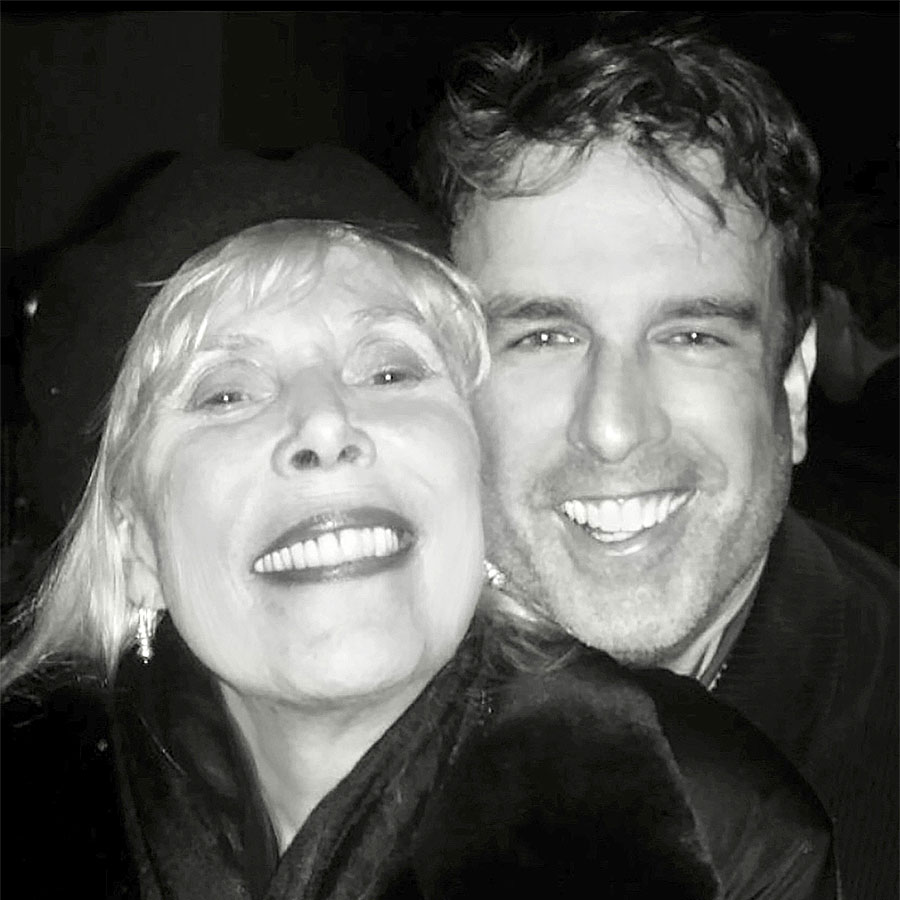
Standing in the doorway, she contemplated my proclamation and took a long drag from her cigarette. Nodding her raised head, she squinted her eyes while she exhaled and in a matter of fact tone declared, “That’s tribal!”
Watching her pointed index finger rock back and forth between us, she confidently asserted, “We’re in the same tribe!”
Needless to say, from that moment on, I was confident I could die a happy man. Joni Mitchell had just told me I was in her f**king tribe.
Urge for Going
My ongoing quest to celebrate Joni Mitchell and her work continued when I flew to Los Angeles in the summer of 2011 to attend a much bigger and brighter version of the “Joni’s Jazz” tribute concert that had occurred 12 years prior. This time, the venue was the Hollywood Bowl, with Herbie Hancock taking on the role of MC and an impressive lineup of guest vocalists, which included Cassandra Wilson, Kurt Elling and Aimee Mann.
Hancock had won the Grammy for Album of the Year Grammy in 2008 for River: The Joni Letters, his masterful reworking of several Mitchell songs, recruiting industry legends Tina Turner and Leonard Cohen as guest vocalists alongside rising stars Norah Jones and Corinne Bailey Rae. The win had been especially remarkable — only the second time in history that a jazz album had prevailed in the Grammy’s most prestigious category. I still vividly remember how Hancock addressed us all at the start of the show, slowly walking to the edge of the stage with a knowing smile on his face before quietly announcing “We all know why we’re here.” The crowd roared, affirming the communal adoration on display that night for the absent Mitchell.
By 2013, an increasingly reclusive Joni had arrived in Toronto for a two-night star-studded tribute in honour of her turning 70 that year. Organized as part of the Luminato Festival, Mitchell herself emerged on Massey Hall’s stage the second night, delivering a spoken word piece based on the journals of Emily Carr and then, after insisting to the press that her vocal chords were shot and that she could no longer perform in public, shifted from speaking to singing the lyrics of her haunting ballad “Furry Sings the Blues” with the audience loudly encouraging her effort.
She followed this up with a rendition of her emblematic anthem “Woodstock,” backed by fellow luminaries like Emmylou Harris, Rufus Wainwright and Glen Hansard. Joni appeared to be thriving on the cusp of this milestone birthday, even inviting the cameras into her L.A. residence the week prior to grant a rare, extended in-person interview to CBC.
Which brings us back to that day at the end of March in 2015, when the internet swirled with rumours of strokes, comas and catastrophic setbacks. With the spectre of death circling from the airwaves, I waited with dread and fading hope of any update that might banish my sense of impending doom.
Since no one seemed willing or able to confirm what had actually happened, conclusions were inevitably drawn that perhaps something had transpired from which there was no way back. I remember reading an op-ed in The Guardian by Linda Grant four days after the news had circulated that Joni had been hospitalized. In her opening paragraph, Grant managed to articulate exactly the feelings that I could not.
She wrote, “For a long time I have worried about where I will be when I hear the announcement of Joni Mitchell’s death. I don’t want it to be when I am in transit, or about to do a literary festival or attend a family celebration. I need to be on my own. I need to close down the internet, draw the curtains and spend the next two days repeatedly listening to the albums Hejira, The Hissing of Summer Lawns, Court and Spark, and Blue. I am going to be traumatized. This won’t be just a death; it is going to feel like an emotional amputation. No other artist has meant as much to me, or has taught me so much about myself.”
Here was a woman an ocean away that was clearly in my tribe — in our tribe — which made me feel less alone in my anticipatory grief.
It would be months before details emerged of a massive brain aneurysm, and the grim probability that the prospect of any significant recovery seemed unlikely. I reluctantly eased myself into accepting this new reality, feeling that the most I could hope for going forward was that Joni was comfortable and had retained some sense of who she was and had previously been. But to entertain any notion of a miraculous recovery and a return to public life felt completely delusional.
In hindsight, however, it now feels utterly foolish of me to have underestimated this woman’s notorious spirit. For, in typical Joni style, she chose to ignore the expectations of others and made up her own rules concerning what she could and could not achieve. Over the course of the next four years, details trickled in from credible sources (like Judy Collins) that Joni’s condition was slowly improving. Random Joni sightings out in the real world followed, wheelchair–bound initially, but quickly advancing to walking with a cane, her physical therapist attentive by her side.
By 2018, Joni had improved enough to be present for a star-studded tribute organized to celebrate her 75th birthday at the Dorothy Chandler Pavilion on her home turf of Los Angeles. And rest assured, I was there, along with performers like Diana Krall, Graham Nash, Seal, Kris Kristofferson, Los Lobos and a newer, younger voice who would end up becoming a game changer in the trajectory of Joni Mitchell’s life and continued recovery: Brandi Carlile.
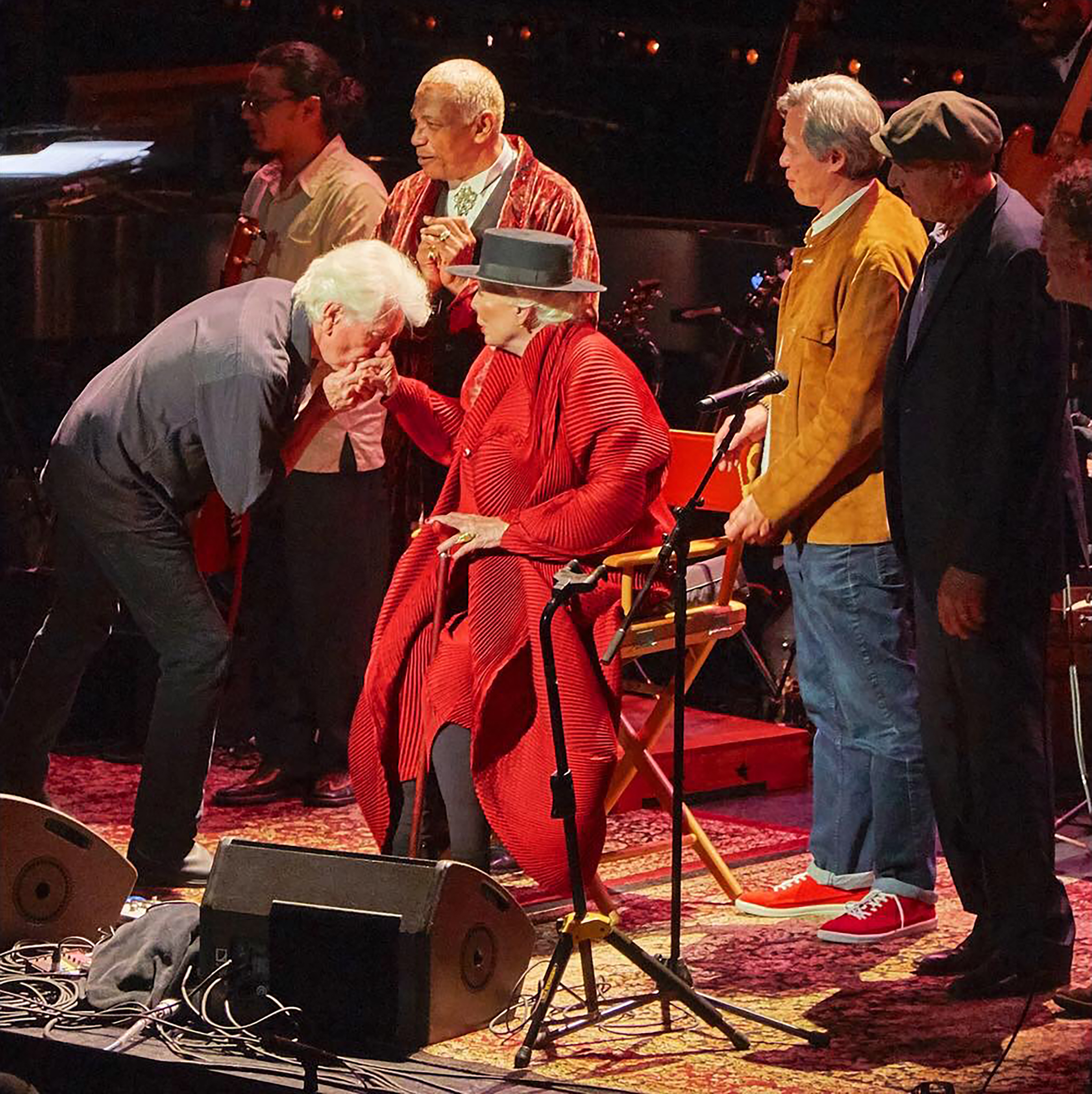
during the final bow at the Dorothy Chandler Pavilion in Los Angeles on Nov. 7, 2018. Behind her is close friend and LGBTQ rights activist Charles “Valentino” Harris, her physical therapist, Sultoon, and singer James Taylor. Photo: Chris Chapman
Lesson in Survival
Carlile had been largely indifferent towards Joni Mitchell in the early stages of her career. But, at the beginning of a budding romance with Catherine Shepherd, the woman who would eventually become her wife, there was obvious friction when Shepherd noticed Carlile bristle towards her adoration of Mitchell. Insisting that Carlile cast off any preconceived ideas of who or what she seemed to think Joni Mitchell was, Shepherd encouraged her to listen to Joni’s work again with fresh ears.
After a gutting realization about the subject matter of “Little Green” (Joni’s heartbreaking lullaby to the baby daughter she had given up for adoption during her time in Toronto), Carlile quickly did a 180, becoming a devout convert eager to now explore Joni’s complete catalogue.
Expanding on what she felt had shifted in her understanding of Joni’s body of work, Carlile explained to Variety’s Chris Willman that ”it changed my life. It didn’t just change the way I view music. It changed the way I view women, and what tough means. So, when I delved into Blue, I made up for lost time.”
After impressing the audience at Joni’s 75th that night with a cover of Court And Spark’s vocally challenging “Down To You,” a friendship began to grow and blossom between the two artists.
Intimate dinners out and numerous invitations to Joni’s home strengthened a bond of mutual support and admiration, ultimately resulting in Carlile mounting a one-night-only event at Walt Disney Hall, performing Joni’s entire seminal 1971 album Blue live on stage with Mitchell’s attendance and endorsement. Introducing herself at the start of the show, Carlile lovingly imparted an indisputable truth, worthy of repeating here, by pointing out, “We didn’t live in the time of Shakespeare, Rembrandt or Beethoven. But we live in the time of Joni Mitchell.” Carlile would repeat the Blue live experience once more the following year, this time at the Mecca of venues for any musician: New York’s Carnegie Hall.
During this time, a monthly tradition had begun to evolve in Joni’s living room. Musical nights with a wide range of diverse artists receiving invitations to attend and “jam” together while Mitchell listened and held court began to happen with increasing regularity, and Carlile’s involvement and participation had been foundational to their success. When the news dropped that Joni was singing again at these gatherings, the online Joni Mitchell fandom groups exploded with joy and disbelief. Did we dare hope this seemingly improbable rumour could be true? Message boards and Facebook forums were on high alert. It seemed that by welcoming music back into her home, a bona fide miracle was about to transpire.
And then, last year on June 24 at the Newport Folk Festival, Joni Mitchell punked the world. Publicly billed as “Brandi Carlile and Friends,” a packed audience was soon informed by Carlile herself that one of those friends was none other than Joni Mitchell. What followed would be heralded as the unofficial return to the stage for Mitchell after almost a decade away.
Accompanied by a crew of regular participants from her living room jam sessions, now affectionately referred to as “Joni Jams,” the musical round table onstage included Carlile, Phil and Tim Hanseroth, Wynonna Judd, Celisse, Jess Wolfe and Holly Laessig of Lucius and other equally talented players. Jaw-dropping video clips went viral as footage of Joni both singing and playing the guitar began to circulate on social media. The highly anticipated live recording of that afternoon’s set was recently released by Rhino Records, the same label charged with the formidable responsibility of organizing and designing Mitchell’s massive archive of unreleased material. Titled Joni Mitchell at Newport, Variety quickly declared the album to be “Proof of a Resurrection” while Pitchfork’s Grayson Haver Currin wrote in his review that “Mitchell’s voice is gorgeous and rich throughout, a piece of high-pile cotton velvet warmed in the daylight.”
Just a few months after that surprise Newport performance, a press release was issued that Mitchell would be headlining for the first time in 20 years at the fourth annual “Echoes Through the Canyon” open–air weekend music festival at the Gorge Amphitheatre, organized and spearheaded by Carlile since it’s inception.
My attempt at procuring a ticket for that show, which had sold out in minutes, proved unsuccessful. It was only after I had abandoned any hope of going that my friend Andrew McFarlane, a fellow fan from San Francisco with whom I’d connected online and eventually met for coffee in Los Angeles by way of Joni’s 75th fête, generously offered me his spare ticket to the event for purchase in late April. I arrived at the Gorge in the early evening on Saturday, June 10, just as Brandi Carlile was beginning to warm up the massive crowd.

After finding my seat in the second row, I connected with Andrew and several others I’d interacted with online but had never met in real life, most notably in the Joni Mitchell Discussion List, a.k.a. JMDL, the OG of online Mitchell fan forums, with at least 100 of its original members still actively involved 27 years after it’s creation in 1996 by founder Les Irwin.
Cameron Crowe, the celebrated director and friend to Joni for decades, could be seen meandering about among the spectators who were seated close to the stage, presumably there conducting field research for the recently announced biopic project about Mitchell’s life he will be writing and directing with Joni’s assistance.
When I congratulated him, expressing my thanks for his taking on what must undoubtedly be a daunting project, he confidently replied that he felt Joni’s fans would be on board around his plans for the film, which have been confidential and undisclosed so far. At around 9 p.m., an impressive roster of acclaimed singers and musicians began to populate the stage, including Annie Lennox, Sarah McLachlan, Marcus Mumford, Allison Russell, Wendy & Lisa (of Prince’s The Revolution fame), Taylor Goldsmith of Dawes, Blake Mills, Mark Isham and more. This group, along with Carlile, would serve as the night’s official “Joni Jammers.”
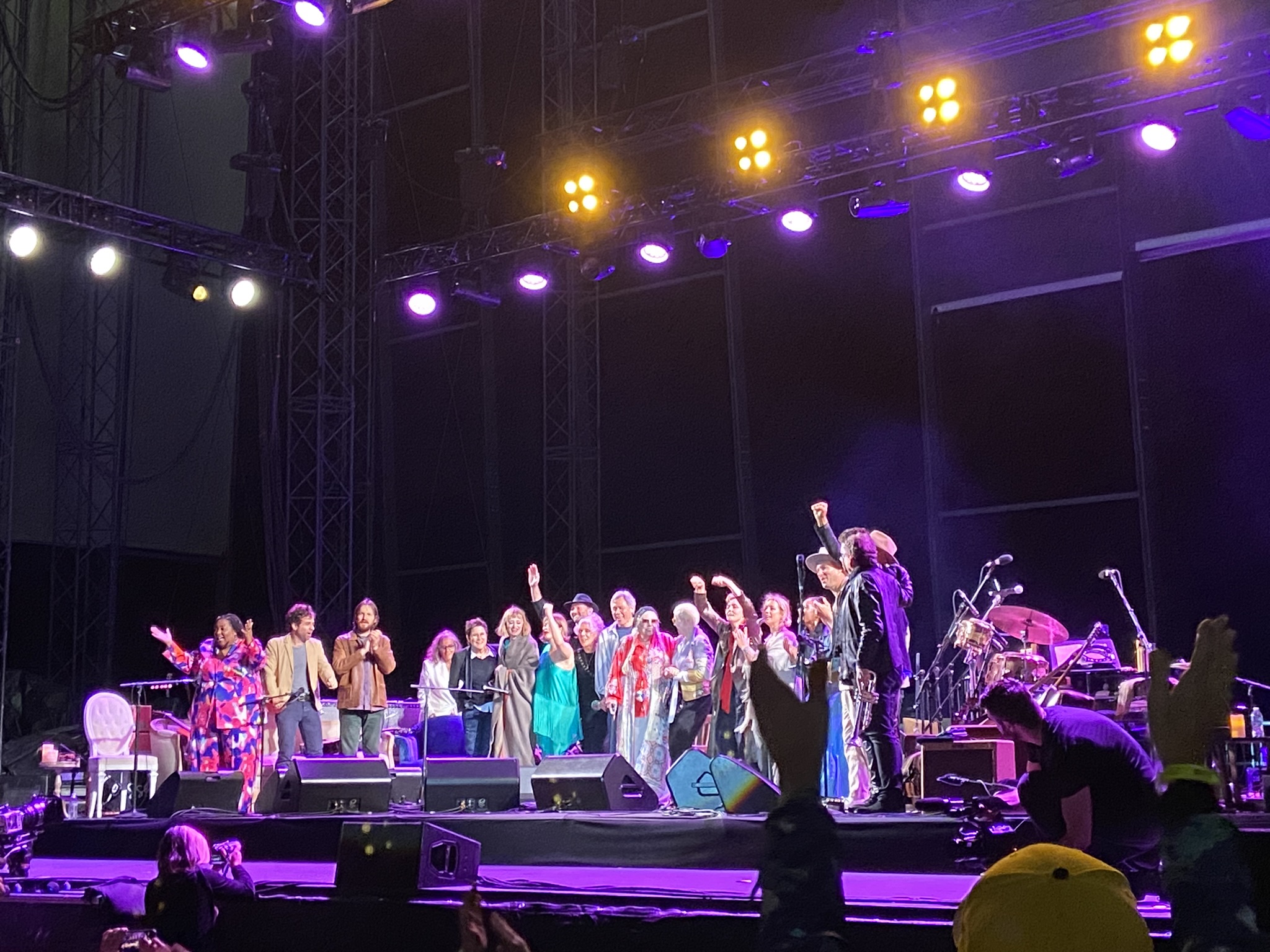
Finally, it was time for the guest of honour to make her entrance, which she did to a tsunami of cheers from the exuberant audience. Once seated and settled, the night unfolded into a well-balanced mix of entertaining banter between Joni and Carlile, individual and group performances that showcased both familiar and lesser-known Mitchell songs, and heartfelt soliloquies by many on stage, all affirming Joni’s enduring legacy and creative genius. Joni appeared to be in good spirits for the entire three-hour set, sporadically declaring “Love wins!” with an infectious chuckle to her fellow musicians and sea of visibly emotional fans. Saving her most impressive turn for the encore, she sang her musical interpretation of Rudyard Kipling’s famous poem “If” accompanied only by herself playing rhythm guitar. Another small miracle I had thought was long out of reach.
I think Lindsay Zoladz, in their glowing review for the New York Times the following day, expressed my overall reaction to the night with precise, metaphoric beauty, when she wrote, “To hear Mitchell hit certain notes again in that inimitable voice was like glimpsing, in the wild, a magnificent bird long feared to have gone extinct.”
Joni’s close friend and collaborator Jean Grand-Maître’s heartfelt words also rang true to me with this message he posted on Facebook: “For the first time in 20 years, Joni Mitchell headlined a concert. Critics are raving. It was a love fest. Joni finally got her own Woodstock. She could not perform at the original because she was booked on The Dick Cavett Show. Yet, there she was, after having had to learn how to walk again for a third time, surmounting all odds, crossing into new generations and always reminding us that compassion, reason, truth and decency still exist in such dark desolate times.”
Bravo Jean. I couldn’t agree more.
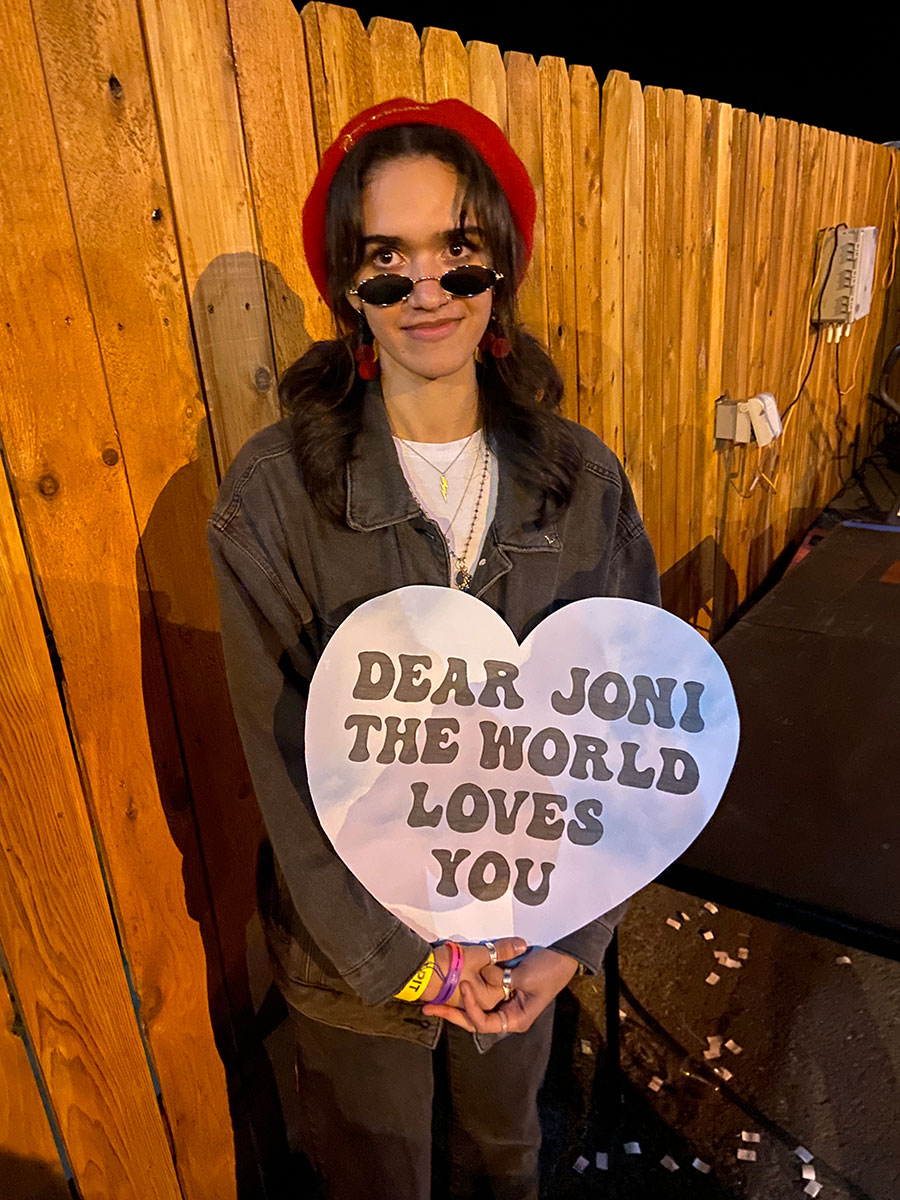
The Circle Game
Joni’s grandchildren, Marlin Kohler, 30, and Daisy Gibb, 24, were both there at the Gorge Amphitheatre bearing witness to their grandmother’s triumphant return to live performance. During the show, Joni had given the pair a shout out, letting slip that both of them were Geminis with birthdays fast approaching, and obviously overjoyed that they were in attendance to share this experience with her.
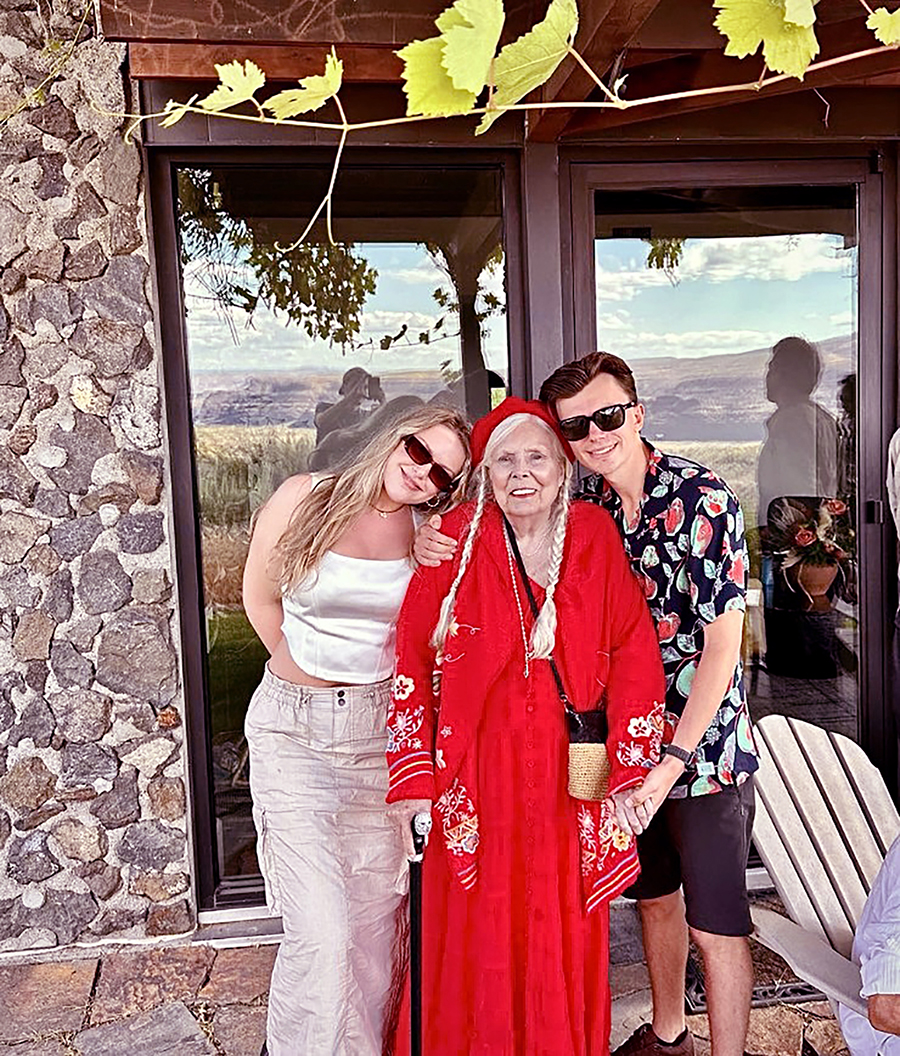
Having met Daisy briefly for the first time in 2013 at the Luminato Festival for Joni’s 70th, we reconnected privately online last year, and then in person at the Gorge afterparty. Once back in Toronto, I asked Daisy if she could give me her perspective on the night and what meaning it held for her.
In her reply, she wrote: “I had never seen my grandmother happier than when I saw her that night at the Gorge. Through all of her life’s many battles, it appears that my granny comes out the other side shining brighter than ever. I personally witnessed the lowest points of her recovery, less than 10 years ago, when she couldn’t speak or move without human assistance. To now watch her return to the stage and do it so elegantly and seamlessly was nothing short of a life-changing experience. I watched her fans cry and laugh and spread joy together! She is so inspiring in a multitude of ways! It was definitely one of the best nights of my life!”
When the concert had ended, an old friend who was part of Brandi Carlile’s team that weekend hand-delivered a pair of brightly coloured wristbands that would grant me access to the official small, private afterparty. Through a maze of checkpoints and Winnebagos behind the massive stage, these two fluorescent Tyvek strips felt like my version of the golden ticket to Willy Wonka’s magical factory.
Once inside, I was able to realize a long-desired dream and personally thank both Carlile and her wife Shepherd for all the positivity and love they had clearly brought into Joni’s life in the preceding four years. I knew that their support had been an integral part of Joni’s reignited desire to be on stage performing again, and I wanted them both to understand how grateful I was to witness Carlile saying publicly to Joni all the things her longtime fans like me wanted to say but couldn’t. Joni herself sat relaxed on a couch, celebratory and engaged, revelling with an assortment of old friends who had made the challenging journey to attend that night. As I quietly exited around 2 a.m., Joni was still going strong — just another confirmation that the Queen of the Night Owls had returned.
I spoke to Carlile again when she was visiting Toronto in July to open for pop superstar Pink at the Rogers Centre. As we discussed what might be next for Joni, Carlile seemed confident in suggesting that Joni could very well have another album of new material left in her to give to the world.
“And if she does,” Carlile continued with a wink, “I can assure you she will be the one in control and calling the shots.”
Was there ever any doubt about that, I thought? Joni has always been available to guide the introspective, her words and music extending an open invitation for us to ride shotgun in her white Mercedes incognito, winding it’s way cross-country along black highways of paradox and duality, of illumination and corruption, of shadows and light.
But make no mistake — she will be the one in the driver’s seat. Something I’ve learned to rely on for a lifetime.
A version of this story was originally published in August 2023.
RELATED:
With Her Return to the Stage, Joni Mitchell Proves Why Our Female Music Elders Are Super Punks
Canadian Music Legend Joni Mitchell Receives Library of Congress Gershwin Prize for Popular Song